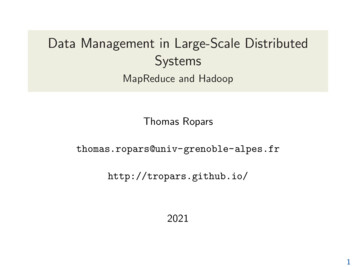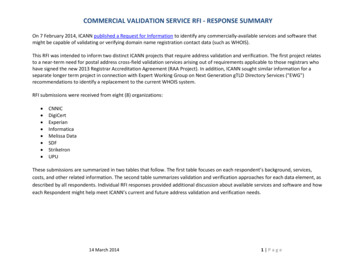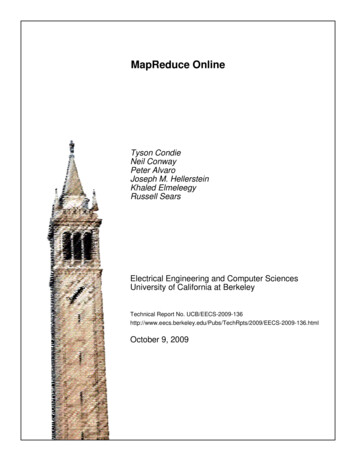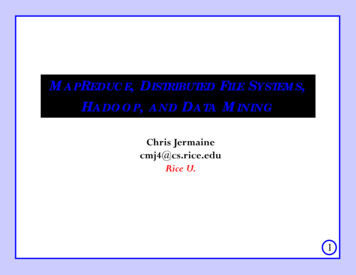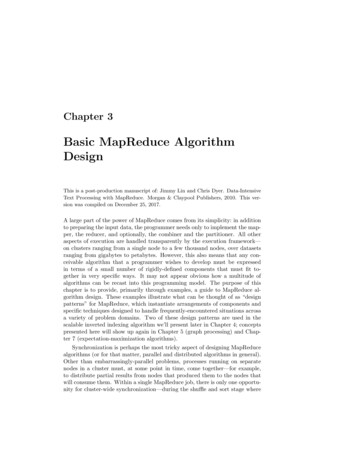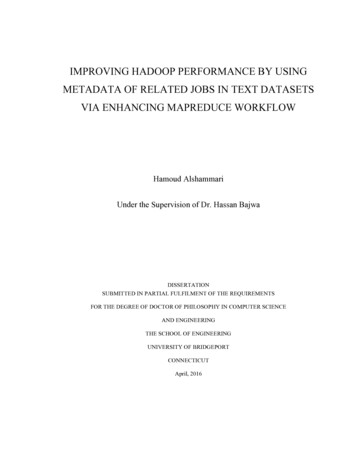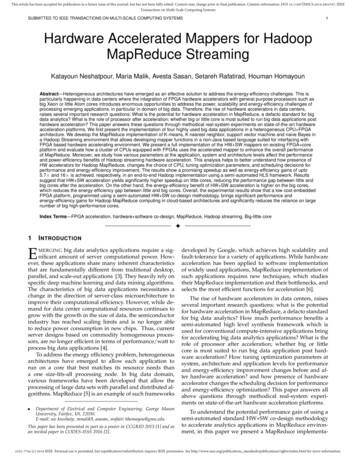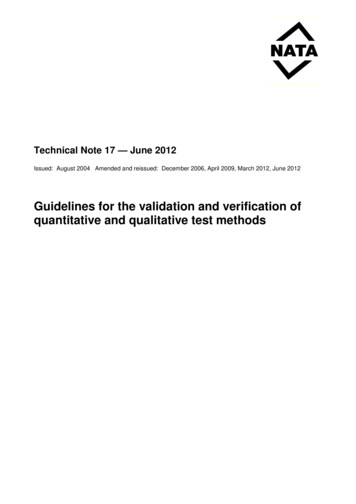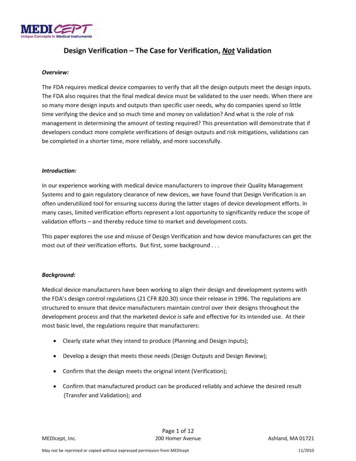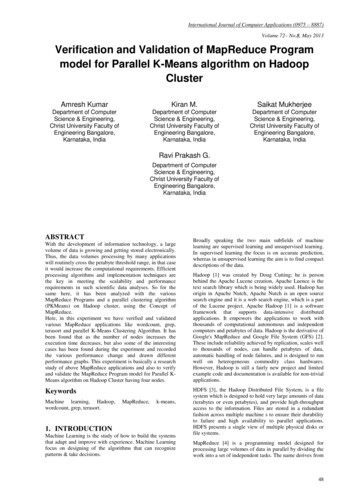
Transcription
International Journal of Computer Applications (0975 – 8887)Volume 72– No.8, May 2013Verification and Validation of MapReduce Programmodel for Parallel K-Means algorithm on HadoopClusterAmresh KumarKiran M.Saikat MukherjeeDepartment of ComputerScience & Engineering,Christ University Faculty ofEngineering Bangalore,Karnataka, IndiaDepartment of ComputerScience & Engineering,Christ University Faculty ofEngineering Bangalore,Karnataka, IndiaDepartment of ComputerScience & Engineering,Christ University Faculty ofEngineering Bangalore,Karnataka, IndiaRavi Prakash G.Department of ComputerScience & Engineering,Christ University Faculty ofEngineering Bangalore,Karnataka, IndiaABSTRACTWith the development of information technology, a largevolume of data is growing and getting stored electronically.Thus, the data volumes processing by many applicationswill routinely cross the petabyte threshold range, in that caseit would increase the computational requirements. Efficientprocessing algorithms and implementation techniques arethe key in meeting the scalability and performancerequirements in such scientific data analyses. So for thesame here, it has been analyzed with the variousMapReduce Programs and a parallel clustering algorithm(PKMeans) on Hadoop cluster, using the Concept ofMapReduce.Here, in this experiment we have verified and validatedvarious MapReduce applications like wordcount, grep,terasort and parallel K-Means Clustering Algorithm. It hasbeen found that as the number of nodes increases theexecution time decreases, but also some of the interestingcases has been found during the experiment and recordedthe various performance change and drawn differentperformance graphs. This experiment is basically a researchstudy of above MapReduce applications and also to verifyand validate the MapReduce Program model for Parallel KMeans algorithm on Hadoop Cluster having four nodes.KeywordsMachine learning, Hadoop,wordcount, grep, terasort.MapReduce,k-means,1. INTRODUCTIONMachine Learning is the study of how to build the systemsthat adapt and improve with experience. Machine Learningfocus on designing of the algorithms that can recognizepatterns & take decisions.Broadly speaking the two main subfields of machinelearning are supervised learning and unsupervised learning.In supervised learning the focus is on accurate prediction,whereas in unsupervised learning the aim is to find compactdescriptions of the data.Hadoop [1] was created by Doug Cutting; he is personbehind the Apache Lucene creation, Apache Luence is thetext search library which is being widely used. Hadoop hasorigin in Apache Nutch, Apache Nutch is an open sourcesearch engine and it is a web search engine, which is a partof the Lucene project. Apache Hadoop [1] is a softwareframework that supports data-intensive distributedapplications. It empowers the applications to work withthousands of computational autonomous and independentcomputers and petabytes of data. Hadoop is the derivative ofGoogle's MapReduce and Google File System (GFS) [2].These include reliability achieved by replication, scales wellto thousands of nodes, can handle petabytes of data,automatic handling of node failures, and is designed to runwell on heterogeneous commodity class hardwares.However, Hadoop is still a fairly new project and limitedexample code and documentation is available for non-trivialapplications.HDFS [3], the Hadoop Distributed File System, is a filesystem which is designed to hold very large amounts of data(terabytes or even petabytes), and provide high-throughputaccess to the information. Files are stored in a redundantfashion across multiple machine s to ensure their durabilityto failure and high availability to parallel applications.HDFS presents a single view of multiple physical disks orfile systems.MapReduce [4] is a programming model designed forprocessing large volumes of data in parallel by dividing thework into a set of independent tasks. The name derives from48
International Journal of Computer Applications (0975 – 8887)Volume 72– No.8, May 2013the application of map ( ) and reduce ( ) functions. In itssimplest form MapReduce is a two-step process: Map stepand Reduce step. In the Map step a master node divides aproblem into a number of independent chunks of problemsthat are allocated to map tasks. Each map task performs itsown assigned part of the problem and outputs results as keyvalue pairs. In the reduce step the node takes the outputs ofthe maps, where a particular reducer will receive only mapoutputs with a particular key and will process those. As theresult of reduce step, a collection of values is produced.This report includes/presents the study and series ofexperiments of various MapReduce Algorithms and ParallelK-Means Clustering algorithm on Hadoop cluster, therebyachieving a collection of sample codes and documentations.The data set used here varies up to 1GB and also there issome of the interesting case for different algorithmimplementation using MapReduce.This Experiment covers Literature review (ResearchClarification & Descriptive Study I) it describes themachine learning, MapReduce and its design, MapReducestrategy, Hadoop, HDFS, and different clustering algorithmswith brief about K-Means & canopy clustering algorithms,cloudera and lists of problems. Methodology (PrescriptiveStudy), it tells about Hadoop architecture, MRProgramming model and Parallel K-Means algorithm. Workdone and result (Descriptive Study II) with the brief ofexperimental setup and experimental results. Finally;conclusion, future work and references.improved understanding of the human genome (thecomplete set of human genetic information, stored as DNAsequences within the 23chromosome pairs of the cellnucleus and in a small DNA molecule within themitochondrion). Machine learning is so pervasive today thatit has been undoubtedly use it many times a day withoutknowing about it. Many researchers also think it is the bestway to make progress towards human-level ArtificialIntelligence (AI). In this way, it will be learned about themost effective machine learning techniques, and practice byimplementing them and getting them to work for our self.There are two major categories of types of learning:Supervised learning and Un-supervised learning. InSupervised learning [9] [15], it is known (sometimes onlyapproximately) that the values of the m samples in thetraining set T. It has been assumed that if a hypothesis h thatclosely agrees with f is been found for the members of T.Then this hypothesis will be a good guess for f especially ifT is large. For example, in case of the classificationproblem, the learner estimates a function mapping a vectorinto classes by looking at the input-output examples of thefunction. Whereas, In Un-supervised learning [9] [15], thereis a training set of vectors without function values for them.The problem in this case, usually, is to divide the trainingset into subsets, t1. . . tr, in some appropriate way.Unsupervised learning methods have application intaxonomic problems in which it is desired to invent ways toclassify data into meaningful categories. Approaches tounsupervised learning include Clustering (e.g., k-means,mixture models, hierarchical clustering).It has been also describe methods that are intermediatebetween supervised and unsupervised learning i.e. Semisupervised learning. Semi-supervised learning [15] is a classof machine learning techniques that make use of bothlabeled and unlabeled data for training - typically a smallamount of labeled data with a large amount of the unlabeleddata. Semi-supervised learning lies between unsupervisedlearning and supervise learning.2.2 MapReduceFig 1: Research Plan: Basic Means, Stages, MainOutcomes2. LITERATURE REVIEW(RESEARCH CLARIFICATION &DESCRIPTIVE STUDY I)2.1 Machine LearningMachine learning [9] is a branch of artificial intelligence,and it is a scientific approach which care of the design andexpansion of an algorithms which take input as empiricaldata, such as data from the sensors or some databases, andyield patterns or predictions, that thought to be features ofthe original mechanism which generated the data. A majoremphasis of the machine learning exploration is the designof algorithms that recognize complex patterns and makeintelligent decisions based on input.Machine learning is the science of making computers thatcan take decisions by its own. In the past days, machinelearning has given us automated cars, auto speechrecognition, effective web searching, and an immenselyMapReduce is a programming model for expressingdistributed computations on massive amounts of data, andalso an execution framework for large-scale data processingon clusters of commodity servers. In other word it can tellthat MapReduce represents to a framework that runs on acomputational cluster to extract the Knowledge from a largedatasets. The name MapReduce is derived from twofunctions map ( ) and reduce ( ) functions. The Map ( )function usually applies to all the members of the datasetand then returns a list of results. And “Reduce ( ) function”collates and resolves the results from one or more mappingoperations executed in parallel.MapReduce Model splits the input dataset into independentchunks called as subsets, which are processed by map ( )and reduce ( ). Generally, compute nodes & storage nodesare the same. That is the entire computation involving map () and reduce ( ) functions will be happening on DataNodesand result of computation is going to be stored locally.In the MapReduce Model, programs written in thefunctional style are automatically parallelized and executedon the large cluster of commodity hardware. The run-timesystem takes care of the details of broken input data, andschedules the program's execution across the number ofmachines; it handles the machine failures, and managesinter-machine communication. In this way without any49
International Journal of Computer Applications (0975 – 8887)Volume 72– No.8, May 2013experience with parallel and distributed systems this allowsprogrammers, to easily utilize the resources of a largedistributed system.2.2.1 MapReduce DesignIn MapReduce, records are treated in isolation by taskscalled as Mappers. The output from the Mappers is thenbrought together into a second set of tasks called asReducers; here results from many different mappers arebeing merged together. Problems suitable for processingwith MapReduce must usually be easily split intoindependent subtasks that can be processed in parallel. Themap and reduce functions are both specified in terms of datais structured in key-value pairs.Apache v2 license. It enables many applications to workwith thousands and thousands of computational independentcomputers and petabytes of the data. Hadoop was derivedfrom Google's MapReduce and Google File System (GFS).Hadoop is a top-level Apache project which is built andused by a global communal of contributors, it has beenwritten in the Java programming language. Hadoop includesseveral subprojects: [1] [3]Table 1. Hadoop Project Components (Sub-Projects)ChukwaDistribute File System; One of theSubject of this ExperimentComputational Framework fordistributed environmentColumn-oriented table serviceDataflow Language and it is a Parallelexecution frameworkData warehouse infrastructureIt is for distributed coordinationserviceCollecting management data: SystemAvroData serialization systemHDFSMapReduceHBaseThe power of MapReduce is from the execution of manymap tasks which run in parallel on a data set and givesoutput of the processed data in form of intermediate keyvalue pairs. Each reduce task receives and processes data forone particular key at a time and outputs the data whichprocesses as key-value pairs.PigHiveZooKeeper2.4 HDFSFig 2: MapReduce key-value pair’s generation2.2.2 MapReduce Strategy (Execution)The Map invocations are distributed across multiplemachines by automatically partitioning the input data into aset of M chunks. The input chunks can be processed inparallel by different machines. Reduce requests are beingdistributed by partitioning the intermediate key space into Rpieces using a partitioning function (e.g., hash (key) modR). The number of partitions (R) and the partitioningfunction are specified by the user. Figure give below showsthe overall flow of a MapReduce operation. As soon as theMapReduce function is called by the user program, thefollowing sequence startsThe Hadoop Distributed File System (HDFS) is designed tostore large data sets with high reliability, and to streamthose data sets with high bandwidth. In a large cluster, morethat thousands of servers both host and Client are directlyattached to storage and execute user application tasks.Hadoop provides a distributed file system and a frameworkfor the analysis and transformation of very large data setsusing the MapReduce paradigm.Fig 4: The architecture of HDFS.Fig 3: MapReduce Execution overview2.3 HadoopApache Hadoop [1] is an open source it is built on Javaframework and it is built for implementing the reliable andscalable computational networks which supports dataintensive distributed applications, and it is licensed underHDFS is the file system constituent the Hadoop. While theinterface to HDFS is being formed after the UNIX filesystem, the truthfulness to standards was sacrificed in favorof enhanced performance for the applications at hand.HDFS stores the file system, metadata and the applicationdata independently. Alike to distributed file systems, likePVFS, Lustre and GFS. HDFS stores metadata on adedicated server, known as NameNode. Application data arestored on other servers known as DataNodes. All servers areconnected and communicate with each other using TCPbased protocols [1].50
International Journal of Computer Applications (0975 – 8887)Volume 72– No.8, May 20132.4.1 HDFS ClientUsing the HDFS client [17], user applications access the filesystem. Similar to most conventional file systems, HDFS ishaving provisions of reading, writing and deleting files, andprovides operations for creating and deleting directories.2.4.2 HDFS Name Node (Master)It manages the file system name space ,keeps track of jobexecution, manages the cluster, replicates data blocks andkeeps them evenly distributed, Manages lists of files, list ofblocks in each file, list of blocks per node, file attributes andother meta-data and also it Tracks HDFS file creation anddeletion operations in an activity log. Depending on systemload, the NameNode and JobTracker daemons may run onseparate computers. JobTracker dispatches jobs and assignssplits (splits) to mappers or reducers as each stagecompletesThe basic steps of the canopy clustering are describedbelow. Given two threshold distance T1 and T2; T1 T2 anda collection of points. Now, to determine the CanopyCenters: there is iteration through the set of points, if thepoint is at distance decide the canopy membership - for eachpoint in the input set if the point is at a distance T1 fromany of points in the list of canopy centers (generated in step)then point is member of the corresponding cluster.2.4.3 Data Nodes (Slaves)It stores blocks of data in their local file system, storesmeta-data for each block, serves data and meta-data to thejob they execute, sends periodic status reports to the NameNode, and sends data blocks to other nodes required by theName Node. Data nodes execute the DataNode andTaskTracker daemons. TaskTracker executes tasks sent bythe JobTracker and reports status.Fig 5: Canopy clustering descriptionThe Map Reduce implementation of K-Means Algorithmwith Canopy Clustering has the following steps.2.5 Clustering AlgorithmsData clustering [5] is the partitioning of a data set or sets ofdata into similar subsets; this can be accomplished by usingsome of the clustering algorithms.2.5.1 K-Means AlgorithmK-MEANS [5] [6] [11] is the simplest algorithm used forclustering also it an unsupervised clustering algorithm. TheK-Means algorithm is used to partitions the data set into kclusters using the cluster mean value so that in the resultingclusters is having high intra cluster similarity and low intercluster similarity. K-Means clustering algorithm is iterativein nature.The K-means clustering algorithm is known to be efficientin clustering large data sets. This clustering algorithm wasoriginally developed by MacQueen , and is one of thesimplest and the best known unsupervised learningalgorithms that solve the well-known clustering problem.The K-Means algorithm targets to partition a set of givenobjects into k clusters based on their features, where k is auser-defined constant. The core idea is to define k centroids,one centroid for each cluster. The centroid for a cluster iscalculated and formed in such a way that it is closely related(in terms of similarity function; similarity can be measuredby using different methods such as cosine similarity,Euclidean distance, Extended Jaccard) to all objects in thatcluster.2.5.2 Canopy Clustering AlgorithmCanopy Clustering [5] [6] an unsupervised pre-clusteringalgorithm related to the K-means algorithm, which canprocess huge data sets efficiently, but the resulting"clusters" are merely a rough pre-partitioning of the data setto then analyze the partitions with existing slower methodssuch as k-means clustering.Fig 6: Map Reduce Steps2.6 ClouderaCloudera [7] [8] Inc. is a software company that providesApache Hadoop-based software, support and services calledCDH. CDH has version of Apache Hadoop patches andupdates.2.7 List of ProblemsDuring the literature review and observation some problemslike scalability issues, high computational costs, reliability,compatibility problems (with the Softwares & Hardwares)has been listed out.3. METHODOLOGY (PRESCRIPTIVESTUDY)3.1 Hadoop ArchitectureThe architecture of a complete Hadoop cluster is in the formof the Master-Slave architecture. Here, in the Hadooparchitecture, Master is NameNode and Slaves areDataNodes.51
International Journal of Computer Applications (0975 – 8887)Volume 72– No.8, May 2013The HDFS NameNode runs the NameNode daemon. Thejob submission node runs the JobTracker, which is thesingle point of contact for a client wishing to execute aMapReduce job. The JobTracker monitors the progress ofrunning MapReduce jobs and is responsible for coordinatingthe execution of the mappers and reducers.parallel parts and serial parts of the algorithms. Now, it hasbeen seen that how the computations can be formalized asmap and reduce operations in detail. So, there got the detailsof PK-Means Algorithm [11] [16] [17] [18] usingMapReduce with the flow diagram shown below.Typically, all these services runs on two distinct machines,although in a small cluster they are often co-located. Thebulk of a Hadoop cluster consists of slave nodes (only threeof which are shown in the figure) that run both aTaskTracker, which is responsible running the user code,and a DataNode daemon, for serving HDFS data.Fig 9: Flow diagram of PKMeans Algorithm usingMapReduce4. WORK DONE AND RESULT(DESCRIPTIVE STUDY II)4.1 Experimental SetupFig 7: Hadoop Cluster Architecture3.2 MR Programming ModelMAP-REDUCE programming model [17] is defined byDean et al. MAP-REDUCE computing model comprises oftwo functions, Map ( ) and Reduce ( ) functions. The Mapand Reduce functions are both defined with data structure of(key1; value1) pairs. Map function is applied to each item inthe input dataset according to the format of the (key1;value1) pairs; each call produces a list (key2; value2).The experiments were carried out on the Hadoop cluster.The Hadoop infrastructure consists of one cluster havingfour nodes, distributed in one single lab. For the series ofexperiments, I have used the nodes in the Hadoop cluster,with Intel Core 2 Duo CPU@ 2.53 GHZ, 2 CPUs and 2GBof RAM for each node. With a measured bandwidth for endto-end TCP sockets of 100 MB/s, Operating System:CentOS 6.2 (Final) and jdk 1.6.0 33 (SUN JAVA).4.2 Experimental Result and its AnalysisIn this Experiment, performance has been shown withrespect to execution time and number of nodes. Here, thereare different cases as given in table below.Table 2. Various cases for verification and analysis.Graphical Analysis of Various Cases using DatasetFig 8: Process of MAP and REDUCE is illustratedAll the pairs which is having the same key in the output listsis kept to reduce function which generates one (value3) oran empty return. The results of all calls from a list, list(value3). This process of MAP and REDUCE is illustratedin figure below.Sr. No.Data SizeNo. of NodesCase 1IncreasingConstantCase 2ConstantIncreasingCase 3IncreasingIncreasing4.2.1 Experiment 01: Sequential Algorithm vs.MapReduce Algorithm3.3 PKMeans Algorithm (Parallel Kmeans Algorithm) [11]Here is the presentation of a design for Parallel K-Meansbased on MapReduce. First, it has been already seen withthe overview of the k-means algorithm and then analyzed52
International Journal of Computer Applications (0975 – 8887)Volume 72– No.8, May 2013Fig 10: Speed of Sequential Algorithm vs. MapReduceAlgorithm4.2.2 Experiment 02: WordcountCase 1: When Data size is increasing and Number of nodesis ConstantFig 14: Results of grep MapReduce ApplicationCase 2: When Data size is Constant and Number of nodesare increasingFig 11: Results of wordcount MapReduce ApplicationCase 2: When Data size is Constant and Number of nodesare increasingFig 15: Results of grep MapReduce ApplicationFig 12: Results of wordcount MapReduce ApplicationCase 3: When Data size is increasing and Number of nodesare increasingCase 3: When Data size is increasing and Number of nodesare increasingFig 16: Results of grep MapReduce ApplicationFig 13: Results of wordcount MapReduce ApplicationIn case of Wordcount ,it has been observed with aninteresting case (Case 3) and also analyzed and verified thatthe execution time is first decreasing and then increasing ,as data size as well as number of nodes are increasing (from1 to 4) because the load on nodes are increasing and thecommunication between nodes are also increasing.In case of Grep experiment, it has been observed with aninteresting case (case 3). It has been analyzed and verifiedthat the execution time in case of Job1 (256MB of DataSize) is showing first decreasing and then increasingpattern. This is happening because the load (Data set Size)is increasing on nodes and as well as communicationbetween nodes is also increasing (From 1 to 4).4.2.4 Experiment 03: TerasortCase 1: When Data size is increasing and Number of nodesis Constant4.2.3 Experiment 02: GrepCase 1: When Data size is increasing and Number of nodesis Constant53
International Journal of Computer Applications (0975 – 8887)Volume 72– No.8, May 20134.2.5 Experiment 04: PKMeans ClusteringAlgorithmCase 1: When Data size is increasing and Number of nodesis ConstantFig 17: Results of terasort MapReduce ApplicationCase 2: When Data size is Constant and Number of nodesare increasingFig 20: Results of PKMeans MapReduce ApplicationCase 2: When Data size is Constant and Number of nodesare increasingFig 18: Results of terasort MapReduce ApplicationCase 3: When Data size is increasing and Number of nodesare increasingFig 21: Results of PKMeans MapReduce ApplicationCase 3: When Data size is increasing and Number of nodesare increasingFig 19: Results of terasort MapReduce ApplicationIn case of Terasort experiment, it has been observed with aninteresting case (Case 2). It has been analyzed and verifiedthat the execution time is first decreases and then increases,when Data size is kept constant and increasing number ofnodes from 1 to 4. This is happening because the load (Dataset size) is constant but the communication between nodesis increasing since number of Node is increasing from 1 to4.Fig 22: Results of PKMeans MapReduce ApplicationIn case of PKMeans experiment, it has been observed withan interesting case (Case 2). It has been analyzed andverified that the execution time is first decreases and thenincreases. The reason behind this is that the load (Data setsize) is constant but the communication between nodes isincreasing, since number of Node is increasing from 1 to 4.54
International Journal of Computer Applications (0975 – 8887)Volume 72– No.8, May 20135. CONCLUSION AND FUTUREWORK[4] Jeffrey Dean and Sanjay Ghemawat “MapReduce:Simplified Data Processing On Large Clusters” 2009,In this experiment, the performance of MapReduceapplication has been shown with respect to execution timeand number of nodes. Also, verified and validated that inMapReduce Program model as the number of nodesincreases the execution time decreases. In this way, it hasbeen shown that PKMeans performs well and efficiently andthe results totally depend on the size of Hadoop cluster. Theperformance of above application has been shown withrespect to execution time, dataset size and number of nodes.The Experiment involves the Hadoop cluster, whichcontains total of four nodes i.e. one master (NameNode) andthree slaves (DataNodes).[5] ,Google, Inc., Usenix Association OSDI ’04:6thSymposium on Operating Systems DesignandImplementation.[6] f[7] http://en.wikipedia.org/wiki/Cluster analysis#Newer developments[8] http://www.cloudera.com[9] https://wiki.cloudera.com/display/DOC/CDH Installation Guide.[10] http://en.wikipedia.org/wiki/Machine learning[11] Mahesh Maurya and Sunita Mahajan. “Performanceanalysis of MapReduce Programs on Hadoop cluster”,World Congress on Information and CommunicationTechnologies 2012.[12] Weizhong Zhao, Huifang Ma, and Qing He, “ParallelK-Means Clustering Based on MapReduce”, 2009.[13] -1996-Fayyad.pdf[14] http://ieeexplore.ieee.org/[15] 23[16] David Barber, “Bayesian Reasoning and MachineLearning”, Cambridge 2011; New York: CambridgeUniversity Press.[17] Ron Bekkerman, Mikhail Bilenko, John Langford,“Scalable Machine Learning” Cambridge UniversityPress, 2012.[18] Jimmy Lin and Chris Dyer, “Data-Intensive TextProcessing with MapReduce”, April 2010, Universityof Maryland, College Park.[19] Tom White, “Hadoop: The Definitive Guide”, 2009Published by O’Reilly Media, Inc., 1005 GravensteinHighway North, Sebastopol, CA 95472.The future research includes developing mechanisms forHadoop quality of service on the different size of thedatasets using MapReduce. Performance evaluation ofMapReduce with different version of software and hardwareconfigurations. Security Issues with respect to Hadoop andMapReduce. The performance of PK-Means Algorithm canbe enhanced by introducing different preprocessing stepssuch as Canopy Clustering algorithm. MapReduce conceptcan be look forward, for the algorithms such as different setof optimization algorithms, different set of Kernelalgorithms.6. REFERENCES[1] Apache Hadoop. http://hadoop.apache.org/[2] Sanjay Ghemawat, Howard Gobioff, and ��03, October 19–22, 2003, BoltonLanding,New York, USA. Copyright 2003 ACM 158113-757.[3] Konstantin Shvachko, Hairong Kuang, Sanjay Radia,Robert Chansler, “The Hadoop Distributed FileSystem”. Yahoo! Sunnyvale, California USA, IEEE,2010IJCATM : www.ijcaonline.org55
Machine learning, Hadoop, MapReduce, k-means, wordcount, grep, terasort. 1. INTRODUCTION HDFS presents a single view of multiple physical disks or . learning and supervise learning. 2.2 MapReduce MapReduce is a programming model for expressing also an execution framework for large-scale data processing on clusters of commodity servers. In .
